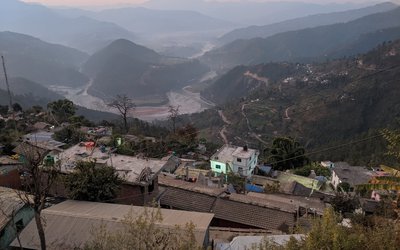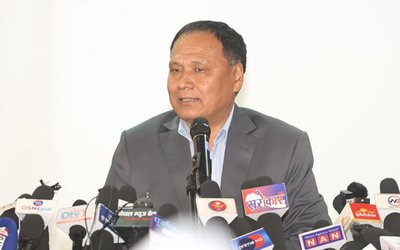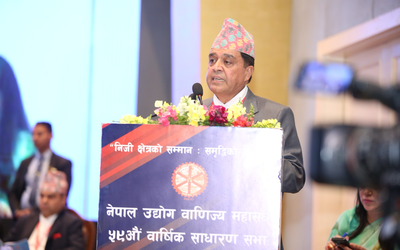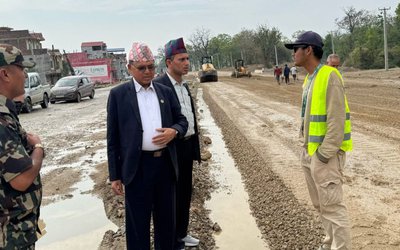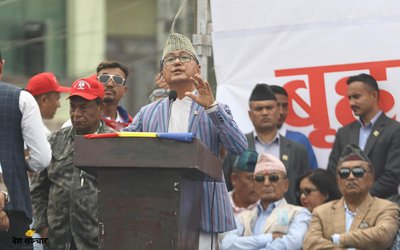
In July 2017, and again at about this time last year (December 2017), I wrote a piece for Spotlight with the same title. Unfortunately, the underlying structural problems remain as bad as they have been in the recent past.
The only positive aspect is that it looks as though the outcome as far as the agricultural sector is concerned will be better than it might have been because of a good paddy harvest, a strong performance by maize producers and also by those producing vegetables, all of which are the result, in large part, of a ‘good’ monsoon. In October, the Ministry of Agriculture and Livestock Development announced that Nepali farmers looked set to harvest the largest paddy crop in history because of timely and sufficient monsoon rains, It was hoped that a record harvest would bring down the country’s rice import bill besides significantly contributing to the government’s economic growth target.
It is now expected that paddy output will hit a record high of 5.61 million tonnes this fiscal year, surpassing the government target of 5.56 million tonnes, and 10 per cent up on the output of the 2017-18 harvest. The production of maize stood at 2.64 million tonnes against the target of 2.69 million tonnes in the first six months of the current fiscal year, and it seems likely that the target will be achieved by the end of the harvesting season. Nepal’s farmers also produced 4.1 million tonnes of vegetables this year as against the target of 4 million tonnes.
Despite this good news, Nepal is set to fall short of the production target for most agricultural products for 2018-19 as laid out in the 14th Plan. According to the Ministry of Agricultural Development (as reported in the Kathmandu Post of 27 December 2018), the underperformance is due to the government’s failure to implement farm mechanization, although one would have thought that this would have been particularly pertinent as regards the cultivation of cereals (which generally did well). Others, like Agriculture Secretary Yubak Dhoj GC, explained the good performance in vegetable production at least by ‘the increased use of capital equipment (which) resulted in higher production’; ‘in addition, adequate and timely rainfall along with the timely availability of fertilizers, use of improved seeds and crop disease control helped to exceed the target’.
Lack of mechanization may well be a part of the explanation for shortfalls in production in the terai, but, in reality, there are many factors that determine agricultural output, one of which is the slow rate of increase in perennial irrigation - less than 30 per cent of farmland in Nepal has round-the-year irrigation - which leaves the agricultural sector as a whole vulnerable to the vagaries of the monsoon which, as climate change takes place, appears to be increasingly unreliable and unpredictable – leading to drought when the monsoon is late and to floods when it is more severe than usual.
In the last fiscal year (2017-2018), Nepal’s paddy output totalled 5.15 million tonnes, down 1.49 percent from the 2016-17 bumper harvest, mostly as a result of record floods in the terai in mid-August following torrential rains that inundated huge tracts of land in 31 districts. In the previous fiscal year 2016-17, the country recorded the highest paddy production in history with a 21.66 percent jump to 5.23 million tonnes. That year, the country achieved a 23-year high economic growth rate of 7.39 percent on the back of a good monsoon that boosted agricultural output. Nepal’s farm sector registered a nine-year high growth rate of 5.32 percent.

Other factors include the structure of land tenure, in particular the land fragmentation that results from the tradition of equal inheritance in farm families, which adversely affects cereal production in particular; and - contrary to what the GC suggested explained the success in vegetable production – serious shortcomings of the inputs distribution system, the poor availability of technical support for farmers, and the persistent inadequacy of marketing chains, particularly for small farmers and petty commodity producers.
It seems likely that the country will fall short, in 2018-2019, of the output target for other farm products. The ministry’s statistics show, for example, that wheat production was 1.94 million tonnes against the target of 2.21 million tonnes. The country will also miss the target for potato production this year. According to the ministry, the country produced 3.08 million tonnes of potatoes, falling below the goal of 3.25 million tonnes. The production of pulses will also fall short of the target of 438,000 tonnes; output so far totals 369,000 tonnes. This is particularly unfortunate, given the importance of pulses in Nepal as a multi-purpose crop, providing a valuable if underestimated contribution to the diets of consumers, acting as both a subsistence crop and a cash crop for domestic and export markets, and also as a source of valuable nutrients for the soil.
According to the ministry, the country will miss the target of meat production by 70,000 tonnes, milk by 509,000 tonnes and fish by 12,870 tonnes. Despite this, it is hoped that national self-sufficiency in milk and meat production will be achieved by the end of fiscal 2018-19. Considering the latest statistics, the government’s commitment to check the country’s ever widening trade deficit by boosting farm production will likely not be fulfilled.
The trade deficit is becoming extremely alarming. It is, by definition, the result of the very low volume and value of exports leaving Nepal and the very high volume and value of imported goods. The trade deficit rose to Nrs 455 billion in the first four months of this fiscal year. In the first four months of the current fiscal year, Nepal imported goods worth approximately Rs400 billion while exports were only worth Rs29 billion.
One of the most striking aspects of the trade deficit is the relatively high level of imports of goods that could easily be produced in Nepal. This is the result of a combination of factors: the lack of a coherent government import substitution policy, made more difficult by the global rules on ‘free trade’; the failure to develop a viable agri-business sector, involving processed agricultural products for both the domestic and export market; the weakness of the industrial sector as a whole, with a desperately poor performance in manufacturing, and the importation of even the most basic consumer goods, including cereals. For example, an estimated 6.1 million tonnes of paddy is needed to meet the country’s annual requirement. The Mota Dhan variety accounts for 70-80 per cent of the paddy grown in the country, but the growing preference for long grain rice among consumers has led to increasing dependence on imported rice.

Efforts to promote investment in production for export, including the 2 per cent ‘export cash incentive’ introduced in 2010-11 and directed mainly at non-agricultural businesses has so far failed to have much impact; the government is now planning to go ahead and increase this incentive to between 3 and 5 per cent depending on the nature of the product and the value added. Producers of goods for export have complained that the incentive is low compared with that given by neighbouring countries and also stress the difficulty they face as a result of the paperwork required and have asked that procedures be simplified and payment be made in cash rather than by letters of credit; exporters have asked that they too receive an incentive as well as producers.
Trade liberalization, which has been an essential element in Nepal’s ‘development strategy’, such as it is, since the 1990s, has not really served it well, despite the potential advantages to be gained. In part, it shares this failure to ‘make good’ through trade liberalization with many other of the 36 Least Developed Countries (LDCs), whose share of world trade remains at around 1 per cent, even though they account for more than 13 per cent of the world’s population. In fact, the LDC share in world exports has actually contracted in recent years, contradicting the declared international aim to raise the LDC share to 2 per cent by 2020. So, there is a battle to be fought by Nepal (and the other LDCs) in the international arena to improve the share of LDCs in world trade and, above all, to increase their share in world exports. LDCs, like Nepal, are required by the World Trade Organization (WTO) to review their trade policy every six years; Nepal conducted its first review in 2012 and was due to undertake another Trade Policy Review in December 2018 – the results of which are pending.
LDCs are already provided duty free access under the Generalised System of Preference and are even permitted to export products with a minimum of 25 per cent value addition. They are also allowed to increase tariffs temporarily to safeguard their domestic industries in case of an import surge. Nepal has failed both to take advantage of what is already on offer and to battle effectively for more concessions; it is critically hampered by its failure to improve the quantity and quality of its exportable goods.
Nepal is also hampered by its relationship with India, its overwhelmingly dominant trade partner, in which its disadvantage is manifest and manifold: nearly two-thirds of Nepal’s trade now is with India and around three-fifths of Nepal’s trade deficit is with India. ‘When India sneezes, Nepal catches a cold’, as they say. Here, a more robust approach to trade and transit negotiations with its giant neighbour to the south, taking advantage of the potential for trade on better terms with China, must be a feature of its strategy for the future.
One crucial area in which Nepal must improve its international position is that of energy policy. The trade deficit is in large part a result of fuel imports, which could be substituted by local renewable non-fossil fuel and alternative energy. Oil imports reached a record high of NRs 173 billion in fiscal 2017-2018, up 43 per cent on the previous year while the total fuel bill had already reached Nrs 69 billion in the first four months of 2018-2019 and accounted for 14 per cent of the country’s total import bill of NRs 484 billion during the period from mid-July to mid-November 2018.
The enormous potential of Nepal’s water resources for the production of hydropower, for electrification, both for the domestic market and for export, has been emphasized for over a century, but relatively little in the way of hydropower development has taken place. Despite foreign aid and investment in this sector, the limited progress made in the construction and realization of hydropower schemes has been one of constant disappointment, as has the failure to construct all the transmission lines need to distribute the energy produced by domestic hydropower plants; as a result of which, domestic power generation has grown desperately slowly in comparison with the need.
Furthermore, most of the hydropower produced by Nepal comes from ‘run-of-the-river’ plants whose output fluctuates according to the water flow; power generation drops sharply during the dry season when there is less water in the rivers. In December 2018, electricity imports from India during peak hours jumped more than 30 per cent following a sharp drop in domestic production due to shrinking water levels in the rivers where a majority of hydropower plants are located. The only power plants with a reservoir are Kulekhani I and II, which together generate some 92 MW. On Monday 10 December, demand reached 1,170 MW according to the Nepal Electricity Authority; the same day, NEA owned hydropower projects generated 445 MW (compared with their total installed capacity of 507 MW) while the privately-owned projects generated 243 MW (well below their combined installed capacity of 520 MW).
As a result of such serious failings, Nepal remains highly dependent on imports of petroleum products, and electricity, from India. On 10 December 2018, the NEA imported 482 MW of electricity; the previous month the amount was 365 MW. The previous winter, Nepal imported around 500 MW during peak hours when domestic generation dropped by a half. The NEA had hoped this year to import significantly less, but low river water levels and delays in the construction of the much-awaited Upper Tamakosi Hydropower Project (planned to generate 456 MW), dashed those hopes. Plans to award more projects to Chinese contractors – such as the China Gezhouba Group for the Budhi-Gandaki Hydroelectric Project – have proved highly controversial.

Infrastructural development, particularly in transport and communications, is also a crucial pre-requisite for development in other sectors, yet Nepal’s transport infrastructure remains inadequate. Its mountainous and hill terrain poses a challenge for effective and sustainable road construction and both the construction of new roads and the maintenance of existing roads are unable to keep up with the demand for safe and speedy transport, both for passengers and for goods. There is a danger of being seduced by the ambitious if not grandiose proposals by China for the building of a ‘New Silk Road’, and yet Nepal cannot afford to turn its back on the enormous investment potential that closer relations with China hold for its future infrastructural development. Even if the notion of a China-Nepal railway link turns out to be a ‘pie in the sky’, the advantage of developing better communications and road transport links to the north is clear.
On the other hand, the development of the transport infrastructure will mean more vehicles on the road and, in so far as Nepal still does not manufacture or even assemble motor vehicles, this will mean more vehicle imports. While some of these are required for the transport of goods within the country and abroad, a substantial proportion of the cost of vehicle imports is for passenger and personal travel, much of it within the major cities, which increases pollution and congestion as public transport remains poorly developed, the vast majority of vehicles are privately owned, and most of them are fuelled by imported diesel or petrol.
One consequence of Nepal’s burgeoning trade deficit is a balance of payments deficit this financial year: foreign exchange reserves have plummeted from last year, as the number of months that imports could be sustained by the foreign exchange reserve has virtually halved from 12 months to 7 months only. In 2015, the number of months was 15. Some commentators consider that Nepal faces today a crisis similar to that faced by India in 1991. In 1991, India’s foreign exchange reserves almost emptied when the country’s balance of payments collapsed. On the other hand a crisis is a point at which decisive action needs to be taken and it could be argued that, in India at least, the balance of payments crisis prompted the dramatic economic reforms undertaken by Manmohan Singh, who was finance minister at the time, reforms that arguably laid the foundations for India’s subsequent period of economic growth.
It is not clear, however, that the government of Nepal has the capacity to undertake the measures that might ‘unleash’ the economy. It is generally accepted practice that an import-dependent country without a sustainable source of foreign currency needs to maintain foreign exchange reserves to handle at least six months of imports. But even with Nepal’s total annual export meeting only 24 days of imports, Nepal Rastra Bank’s policy is to maintain foreign exchange reserves to last at least 8 months. This strategy is heavily reliant, however, on a continuing high level of foreign exchange flowing into the country in the form of remittances, sent back by Nepali workers abroad. Some 65 per cent of Nepal’s total import bill is paid through remittances, while exports constitute only 6 per cent and investment only 17 per cent of Nepal’s annual foreign exchange income that is used to pay for imports.
It is the flow of remittances that currently prevents the economy of Nepal But even with all these sources combined, Nepal cannot meet 12 per cent of its import bill, which is what is leading to the balance of payment deficit. The country has been forced to dip into its foreign exchange reserves to meet the gap. The balance of payments deficit may compel the government to adopt a restrictive monetary policy, but that is likely to mean either more foreign borrowing or a reduction in imports to prevent the outflow of hard currency. The easiest option would be to borrow, but this is always costly and could be painful; it also avoids any difficult decisions and arguably stores up more problems in the future. Nepal’s reliance on foreign ‘aid’ is already seriously criticized in some quarters as increasing the burden of debt and also creating a culture of dependency which inhibits the necessary domestic reforms and structural transformation of the economy.
Restricting imports also carries with it a number of disadvantages, for while a significant proportion of the import bill is for what might be termed luxury goods, and for goods that could, under the right conditions, be produced in Nepal (as indicated above), much of what is imported is at present required for key sectors of the economy: fuel and electricity, vehicles and other manufactures, construction materials, etc. Also, restrictions on imports tend to increase the domestic price of the commodity concerned and stimulate a black market and smuggling. Earlier this year, when the government applied quantitative restrictions on the import of sugar, the price immediately shot up by NRs 5 per kg.
Depleted reserves could put pressure on Nepali fixed exchange rate with the Indian currency. This could result in capital flight to India, as has occurred in the past. Worse, if there is a devaluation of the Nepali rupee it will raise inflation and that could lead the economy into a downward spiral. The banking sector is already in difficulties and some would say in crisis. One other area that gives grounds for concern is the gap in the service sector. While most of the current outflow is for energy and vehicle imports, there is also a substantial (and largely ignored) outflow due to students, medical patients and other Nepalis travelling abroad; few people know that Nepali tourists spent Rs35 billion abroad in the four months of this fiscal year, while foreign tourists spent only Rs25 billion in Nepal during the same period.

It has been the case for many years now that remittances tend to be spent for the most part on improving the standard of living and levels of consumption of the recipient households, investment in house construction and improvement, and in education – all of which tend to increase the demand for imported goods and services and make only a limited contribution to domestic production. On the other hand, remittances contribute more than foreign direct investment, foreign ‘aid’ and tourism combined, and have undoubtedly made a significant contribution to the reduction in poverty in local communities and among households across the country. Without remittances, the state of the economy would be even more dire than it is. Also, despite the global ‘crash’ of 2008 and subsequent decade of slow recovery, the volume and value of remittances from Nepalis working abroad have held up well, and has proved more reliable than most other sources of income, including agriculture, on which so many still depend for their livelihoods.
In the long run, however, there can be no satisfactory alternative than a radical transformation of the economy, to increase both public and private investment, to increase production and value added both for the domestic and for the export market, to create employment and incomes in Nepal rather than rely on workers living abroad, and to take advantage of the country’s natural and human resources more effectively than it does today.
This will require an effective government strategy for sustainable development and a marked improvement in the competence and capability of the state bureaucracy to coordinate and to implement effectively the policies, programmes and projects that emanate from a coherent development strategy. It will also require raising local resources and revenues, and promoting and delivering effective investment (both public and private) where most needed – at national, provincial and local level – in a coordinated fashion.
As the preparations begin for the next Five Year Plan, it is worth pointing out that, over many years now, the government services responsible for different aspects of Nepal’s social and economic development have proved woefully incapable of spending the funds allocated in successive plans and annual budgets on the development programmes and projects identified in those plans and budgets. Four months into the 2018-2019 fiscal year only 11 per cent of the budgeted capital expenditure had been spent. In the same period, however, the government spent three times that amount as current expenditure - on salaries, administrative costs, vehicle purchase, foreign trips, allowances and overheads.
Federalism is already proving a very costly business, as provincial governments demand more resources from the centre, to establish themselves as viable entities. The tug-of-war involved seems likely to continue for a long time, despite earlier commitments to allocate a significant proportion of national resources to these new administrations. In the meanwhile, most provincial governments have so far managed to spend very little indeed – one estimate suggests about 1 per cent – of their capital budget in the first quarter of the year. Unless this situation changes, very soon, the negative effects of ‘federalism’ on the national economy will not just be a consequence of growing real current expenditure on such things as new buildings, new fleets of vehicles and new equipment, the wages and salaries of civil servants and the perks and allowances of politicians at the provincial level, but will also include the implications of development foregone – capital investment not undertaken and not realised.

Dr.David Seddon
Seddon is a development analyst with a long involvement in Nepal. He is co-author, among other works, of Nepal in Crisis: growth and stagnation at the periphery, and has contributed previously to New Spotlight.
- The Potential for Tourism from the Gulf – and China
- Mar 08, 2025
- The (Poor) State of the Economy – Re-Visited
- Jan 07, 2018
- The (Poor) State Of The Economy
- Aug 12, 2017
